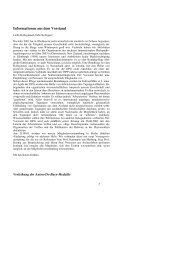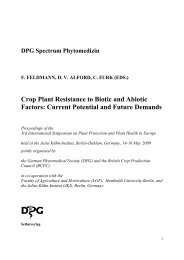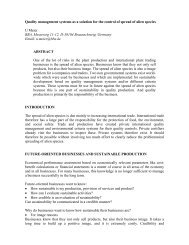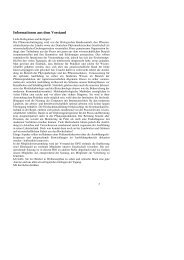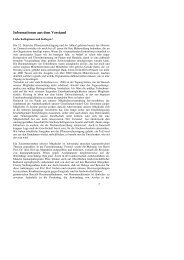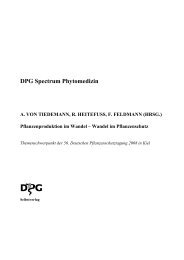PHYTO MEDIZIN Mitteilungen der Deutschen ... - Die DPG
PHYTO MEDIZIN Mitteilungen der Deutschen ... - Die DPG
PHYTO MEDIZIN Mitteilungen der Deutschen ... - Die DPG
Sie wollen auch ein ePaper? Erhöhen Sie die Reichweite Ihrer Titel.
YUMPU macht aus Druck-PDFs automatisch weboptimierte ePaper, die Google liebt.
The spread of Rice yellow mottle virus in irrigated rice crops<br />
S Sarra 1,2 and D Peters 2; 1 Institut d’Economie Rurale, Projet Riz Irrigué, Niono, Mali;<br />
,2 Laboratory of Virology, Wageningen University<br />
Rice yellow mottle virus (RYMV), a sobemovirus, is endemic in Africa, south<br />
of the Sahara, and occurs mainly in irrigated rice ecosystems. Infected plants<br />
give yellow or orange discoloured rice leaves, a delay in plant growth and<br />
reduced tillering. These symptoms result in lower yields, but early infected<br />
plants give the highest losses as they fail to set fruit. RYMV is primarily<br />
known as a beetle-transmitted virus. A scattered distribution of infected<br />
plants and the occurrence of small infected spots might be the result of<br />
RYMV spread by beetles. However, various infection patterns can with difficulty<br />
be explained by beetle transmission. Small infected spots occur next to<br />
field-wide spots (20 m or more in diameter). Completely infected crops are<br />
found next to completely healthy crops. Infected plants can be found on untided-land<br />
along roadsides, levees and at corners. Severe infections can occur<br />
in parcels in which cows have been housed for the night in the contra-season.<br />
These observations stimulated us to search for other mechanism by which<br />
RYMV could spread in the field. Transplantation of seedbeds with a limited<br />
infection resulted in a drastic increase of infected plants in the field. This<br />
number increased again sharply 3 to 4 weeks after transplantation due to<br />
wind-mediated leaf contact and root-released virus from infected plants as<br />
shown in field and greenhouse experiments. Weeding, application of fertilizers<br />
may also enhance the number of infected plants. Some infections are<br />
caused by cows and donkeys occasionally fouraging on rice, and by grass rats<br />
gnawing plant on tided land. Mowing an infected crop, and fouraging stubble<br />
fields enhance the inoculum which can infect the next seedbed by virus released<br />
from infected plants when plowed down and other mechanisms such<br />
as beetles and rats. Some severe seeded infections can occur when frequented<br />
by cows. The spread and epidemiology of RYMV as deduced from our results<br />
will diagrammatically be presented.<br />
Identification of viruses in ornamental Allium species and control strategies<br />
KTK Pham, MEC Lemmers, PJ van Leeuwen, VP Bijman and AFLM Derks; Applied<br />
Plant Research, section Flowerbulbs, Lisse<br />
In Allium giganteum, the most important ornamental onion grown in the<br />
Netherlands, a virus disease occurs showing symptoms of light green to yellow<br />
stripes on the leaves, a smaller inflorescence and/or a twisted flower<br />
44




